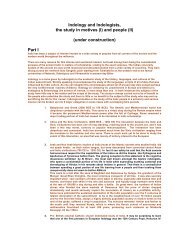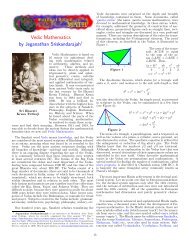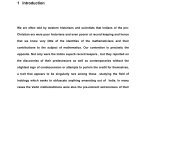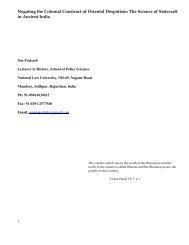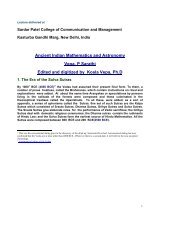The Dhaarmik Traditions - Indic Studies Foundation
The Dhaarmik Traditions - Indic Studies Foundation
The Dhaarmik Traditions - Indic Studies Foundation
You also want an ePaper? Increase the reach of your titles
YUMPU automatically turns print PDFs into web optimized ePapers that Google loves.
45 equinox, vernal<br />
equinox<br />
वसंतसंपत<br />
,(Vasanth<br />
Sampat),autumna<br />
l equinox<br />
nnualjourneythroughtheheavenswiththeeclipticasitspath.<strong>The</strong>eclipticistheprincipalaxisint<br />
heeclipticcoordinatesystem.<strong>The</strong>twopointsatwhichtheeclipticcrossesthecelestialequatorar<br />
etheequinoxes.<strong>The</strong>obliquityoftheeclipticistheinclinationoftheplaneoftheecliptictotheplane<br />
ofthecelestialequator,anangleofabout231/2°.<strong>The</strong>constellationsthroughwhichthe ecliptic<br />
passes are the constellations of the zodiac .<br />
either of two points on the celestial sphere where the ecliptic and the celestial equator<br />
intersect. <strong>The</strong> vernal equinox, also known as “the first point of Aries,” is the point at<br />
which the sun appears to cross the celestial equator from south to north. This occurs<br />
about Mar. 21, marking the beginning of spring in the Northern Hemisphere. At the<br />
autumnal equinox, about Sept. 23, the sun again appears to cross the celestial equator,<br />
this time from north to south; this marks the beginning of autumn in the Northern<br />
Hemisphere. On the date of either equinox, night and day are of equal length (12 hr each)<br />
in all parts of the world; the word equinox is often used to refer to either of these dates.<br />
<strong>The</strong> equinoxes are not fixed points on the celestial sphere but move westward along the<br />
ecliptic, passing through all the constellations of the zodiac in 26,000 years. This motion<br />
is called the precession of the equinoxes . <strong>The</strong> vernal equinox is a reference point in the<br />
equatorial coordinate system .<br />
46<br />
47<br />
48 Gaudapada Proponent of Advaita Vedanta and well versed in Buddhism. His most celebrated work is<br />
the Kaarika (Gloss) on the Mandukya Upanishad<br />
49<br />
50 Gotra A term applied to a clan, a group of families, or a lineage - exogamous and patrilineal -<br />
whose members trace their descent to a common ancestor, usually a<br />
51 Grihastya <strong>The</strong> second stage of the varna Ashrama system, namely that of a householder or<br />
married man or woman.<br />
52 Gunas <strong>The</strong>re are 3 Gunas , Sattwa, Rajas and Tamas and these three Gunas occur in each and<br />
every individual in varying degrees. <strong>The</strong> relative proportion of each in the total<br />
determines the essential nature of the individual. It follows that at any given time a<br />
individual, may exhibit different modes of behavior as his personality matures and<br />
develops. <strong>The</strong> son of a Brahmana may choose not to follow the priestly vocation and<br />
may elect to go into law. As a general rule of thumb one elects to be in a profession<br />
which utilizes his Gunas fully. For example Brahmanas tend to cluster around intellectual<br />
pursuits (teaching, legal, corporate management, administration etc. In the past the<br />
choice of professions available to Brahmanas were limited to priestly duties and the<br />
services he could render as a Minister to the Maharaja including mundane tasks such as<br />
accounting and cooking. In recent years substantial numbers of Brahmanas faced with<br />
increasing discrimination from their own government have elected to go into Business,



